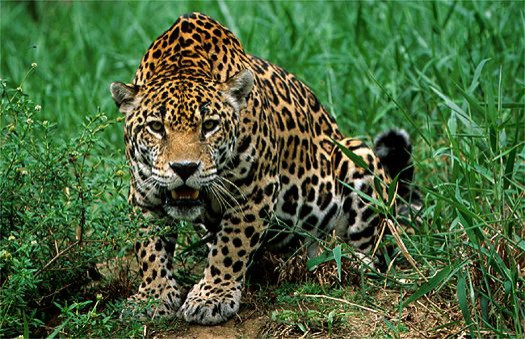Vanishing Jungles: Guyana Moves To Save Its Jaguars

The government of the South American nation of Guyana said it will join regional efforts to save one the most beautiful animals on earth from extinction, the jaguar, the largest land predator in the Americas.
The Associated Press reported that jaguar numbers have been decimated by expanding agriculture and mining projects that have penetrated the big cat’s natural habitat.
In response, Guyana’s Environment Ministry signed an agreement with Panthera, a New York-based wildcat conservationist group, under which countries will seek to form a “jaguar corridor” that would ultimately connect jaguar populations from Mexico to Argentina.
In a statement, Panthera said that this agreement can strengthen the effectiveness of Guyana’s Protected Areas System for wildlife and outline the “most effective initiatives to conserve the nation’s jaguars.”
Guyana, where the jaguar is the national animal, has some of the most unspoiled dense rain forests and jungles in Latin America.
In the southern Rupununi savannah near the borders of both Brazil and Venezuela, scientists recorded the presence of three to four jaguars per 100 kilometers (161 miles), a relatively high density for the creature. This suggests that authorities should also seek to preserve grasslands as well as rain forests in order to save threatened species like the jaguar.
A report in Guyana’s Starbroek News said jaguars are “top predators in the forest and savannahs and are excellent swimmers. They are stocky and strong and stalk their prey rather than chase it. They will hunt at any time of the day or night, using their powerful jaws and teeth to pierce the skull of their prey, a technique unique to jaguars and very useful for cracking the shells of turtles, one of their favorite prey. Other prey include capybara, deer, monkeys and fish. In areas where humans live, jaguars will also prey on domestic animals such as dogs and cattle.”
The report added that jaguars are secretive, “but, like many wild cats, they take advantage of man-made trails and roads in the forest, so, sometimes, lucky travelers can see jaguars on the trail.”
The AP noted that jaguars once roamed freely from what is now the southwestern U.S. all the way to Argentina but that their population has faced decline from loss of natural habitat, hunting and fur traders.
Panthera estimates that as many as 18,000 wild jaguars were killed every year until 1973 when the Convention on the International Trade in Endangered Species, or CITES, largely ended the pelt trade.
“Today, jaguars continue to be hunted due to conflict with humans who live in fear of them or view them as a threat to their livelihoods,” Panthera noted.
Jaguars currently live in 18 Latin American countries, despite the fact that they have been eliminated from more than 40 percent of their historical range.
The actual number of jaguars still remaining in the wild is unknown.
Panthera also praised Guyana’s tradition of preserving its natural habitats, unlike most other Latin American and developing nations rich in natural resources. Indeed, in 2009, the Guyanese commenced a low-carbon program to minimize deforestation and fight against climate change.
© Copyright IBTimes 2024. All rights reserved.





















